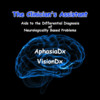Clinicians Assistant
Detailed App Info:
Application Description
Reviewed in the medical journal, The Lancet Neurology, on 11/15/11, in the article, "The Virtual Neurologist." Niall Boyce, the reviewer writes, "A focused approach to clinical history and examination" ... "simple, smart and fast" ... "excellent value for the money" ... "very useful for trainees."
Clinician's Assistant provides assistance for the differential diagnosis of 8 types of aphasia and 10 paradigms of neurologically based vision disturbance.
AphasiaDx-
The classification of aphasia type and the corresponding involved areas of the brain can be fairly well determined based upon the patient's speech fluency, verbal comprehension and ability to repeat what is heard. This is well documented in Neurology and Aphasia text books such as:
"Neuroanatomy through Clinical Cases" by Hal Blumenfeld, MD PHD of the Yale University School of Medicine (page 834, published 2002 by Sinauer Associates, Inc)
"Aphasia, A Clinical Perspective" by D. Frank Benson MD, Professor Emeritus of Neurology at UCLA and Alfredo Ardila PhD, Clinical Neuropsychologist at Miami Institute of Psychology (page 94, published 1996 by Oxford University Press)
"Principles of Neurology" by Raymond D. Adams MA MD FRSM, Bullard Professor of Neuropathhology, Emeritus, Harvard Medical School and Maurice Victor MD, Professor of Medicine and Neurology, Harvard Medical School (page 427, published 1977 by McGraw-Hill, Inc)
and numerous other neurology, neuropsychology and aphasia textbooks.
The clinician should respond to the questions posed by Clinician’s Assistant based upon that clinician’s observation and testing of the patient. The probable brain areas involved in producing the patient's anomaly and a description of the specific syndrome are provided.
VisionDx-
Defects in visual functioning, that can be detected by examination of the visual fields, provide excellent information for the localization and diagnosis of brain lesions.
A visual fields examination should be conducted on each eye separately. With the data at hand from the visual fields examination, the clinician should browse through the graphic displays, provided within this program, until s(he) finds one that most closely resembles the examination results.
The probable brain areas involved in producing the patient's anomaly are provided along with possible associated vascular distributions where appropriate.
Clinician's Assistant provides assistance for the differential diagnosis of 8 types of aphasia and 10 paradigms of neurologically based vision disturbance.
AphasiaDx-
The classification of aphasia type and the corresponding involved areas of the brain can be fairly well determined based upon the patient's speech fluency, verbal comprehension and ability to repeat what is heard. This is well documented in Neurology and Aphasia text books such as:
"Neuroanatomy through Clinical Cases" by Hal Blumenfeld, MD PHD of the Yale University School of Medicine (page 834, published 2002 by Sinauer Associates, Inc)
"Aphasia, A Clinical Perspective" by D. Frank Benson MD, Professor Emeritus of Neurology at UCLA and Alfredo Ardila PhD, Clinical Neuropsychologist at Miami Institute of Psychology (page 94, published 1996 by Oxford University Press)
"Principles of Neurology" by Raymond D. Adams MA MD FRSM, Bullard Professor of Neuropathhology, Emeritus, Harvard Medical School and Maurice Victor MD, Professor of Medicine and Neurology, Harvard Medical School (page 427, published 1977 by McGraw-Hill, Inc)
and numerous other neurology, neuropsychology and aphasia textbooks.
The clinician should respond to the questions posed by Clinician’s Assistant based upon that clinician’s observation and testing of the patient. The probable brain areas involved in producing the patient's anomaly and a description of the specific syndrome are provided.
VisionDx-
Defects in visual functioning, that can be detected by examination of the visual fields, provide excellent information for the localization and diagnosis of brain lesions.
A visual fields examination should be conducted on each eye separately. With the data at hand from the visual fields examination, the clinician should browse through the graphic displays, provided within this program, until s(he) finds one that most closely resembles the examination results.
The probable brain areas involved in producing the patient's anomaly are provided along with possible associated vascular distributions where appropriate.
Requirements
Your mobile device must have at least 15.77 MB of space to download and install Clinicians Assistant app. Clinicians Assistant was updated to a new version. Purchase this version for $2.99
If you have any problems with installation or in-app purchase, found bugs, questions, comments about this application, you can visit the official website of Neuroscience Center of Indianapolis Inc at http://www.neuropsychonline.com.
Copyright © 2012 Neuroscience Center of Indianapolis



